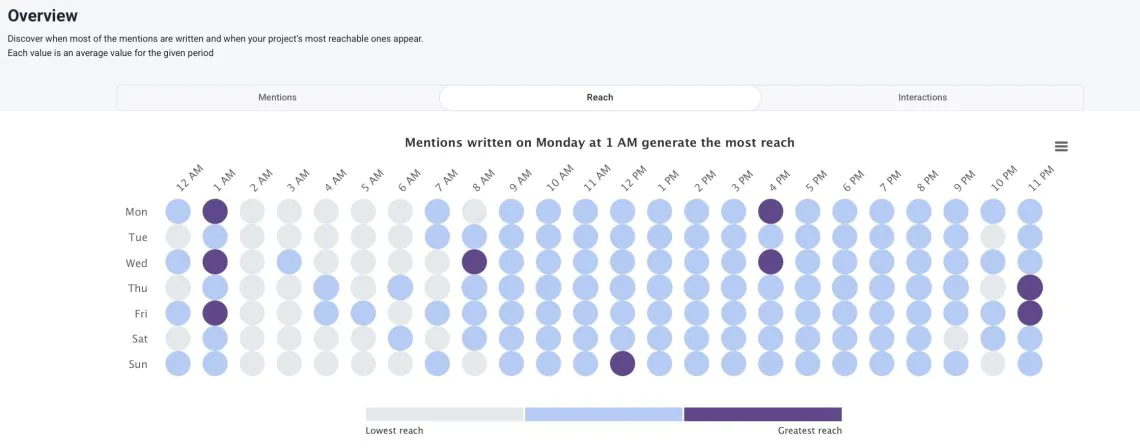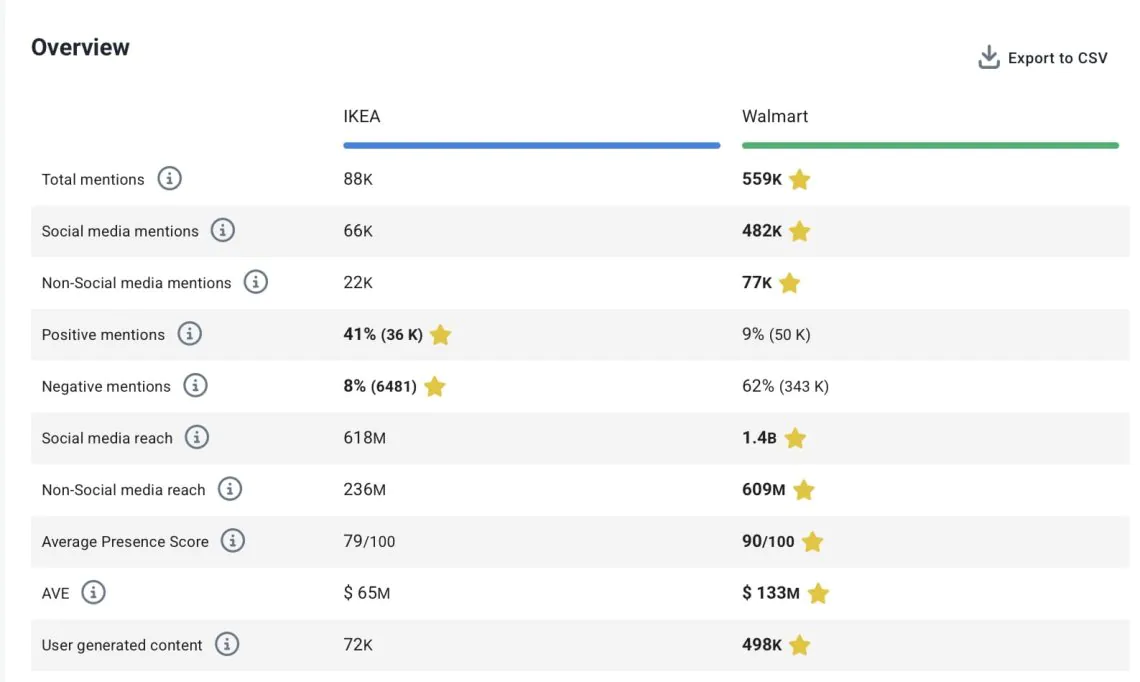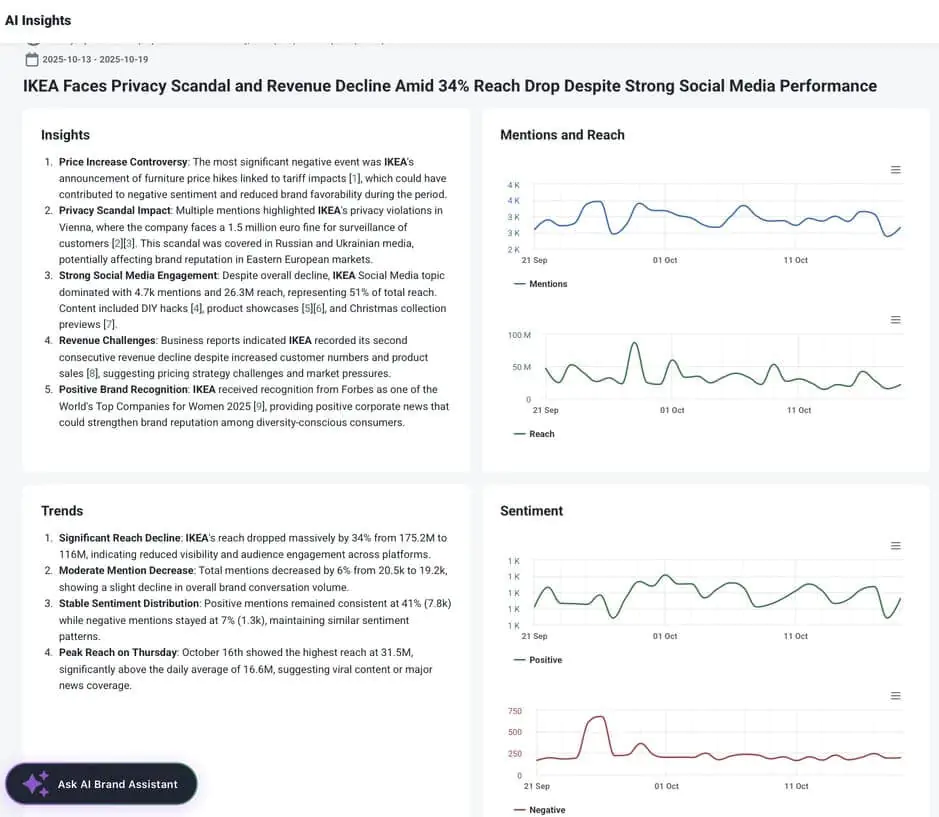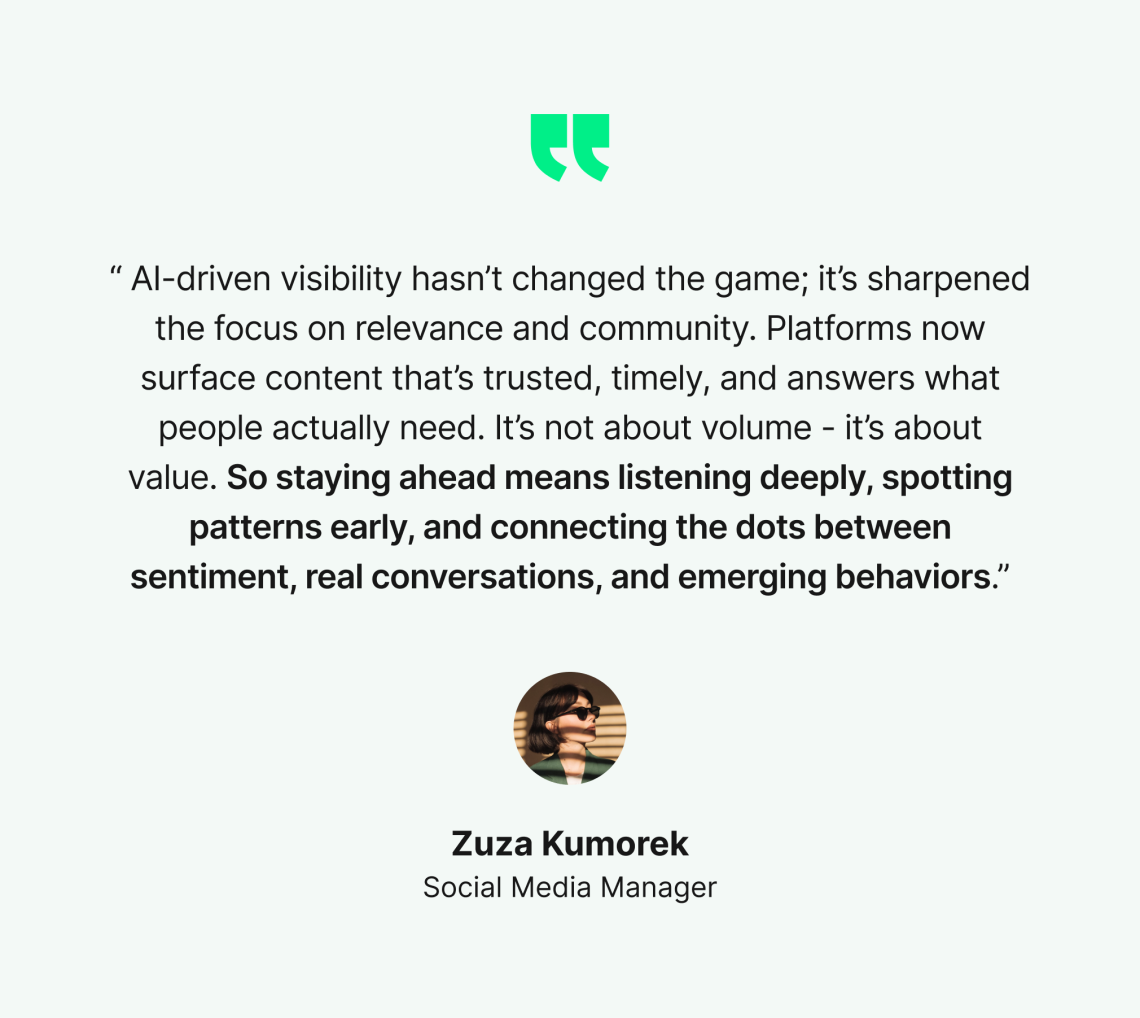Top Social Media Insights in 2026 to Boost Engagement
Table of contents
In 2026, social media insights will be the key to understanding what truly drives engagement and growth. With advanced social media analytics and AI-powered tools, brands can now dig much deeper into audience insights, uncovering hidden patterns, preferences, and behaviors that shape online conversations.
In this article, we’ll dive into the latest social media trends and strategies shaping the future of social media management.
From personalized content strategy to real-time conversations, you’ll see how to turn audience analysis into action, build stronger relationships, and boost brand loyalty.
- Social media insights are valuable, data-driven findings about your overall social media strategy, including customers, content, competitors, influencers, and more.
- With advanced social media analytics, you can track brand mentions across different platforms and uncover what truly drives engagement on your social media network.
- By analyzing and interpreting key social media metrics, such as demographics, engagement rates, and conversions, you can refine your marketing efforts to create more targeted content. This helps you boost engagement, stay ahead of competitors, and connect with your audience in a more meaningful way.
- Turning insights into real action is the key to business success. Using data from social media analytics to guide your decisions allows you to optimize campaigns, improve performance, and continuously grow your brand presence online.
What are social media insights?
We define social media insights as valuable data that reveals trends, patterns, and audience behaviors. These insights go beyond likes and shares. We’re talking about something much deeper.
It’s all the findings that help explain why certain things happen across your social media network.
Let’s divide!
9 key social media insights:
Social media is evolving fast, and staying ahead means focusing on what truly works.
Here’s a practical list of 9 key strategic insights for 2026 that you can easily apply to your strategy.
01 Audience insights
Audience insights are all key data points about their preferences, needs, to identify pain points, motivation, and values.
They can be divided into 4 categories. Let’s break this down:
- Demographics: basic audience segmentation factors such as age, gender, location, and nationality.
- Interests & lifestyle: identifying interests, hobbies, and key topics for the social media audience, which will allow you to personalize your marketing activities.
- Behavior: From the type of content they engage with to the times they’re most active, analyzing consumer behavior gives you the power to refine your ads and design more impactful social media campaigns.
- Motivation: The “why” behind their choices, both emotional and rational, to connect on a deeper level.
Understanding your followers is the secret weapon of social media marketing success.
They uncover the real story behind your followers, helping you shape a stronger social media content strategy and connect more deeply with your target audience.
How to use audience insights?
Once you’ve gathered your audience insights, the next step is to turn them into buyer personas (detailed profiles of your ideal customers).
I like to apply social media monitoring for this process, as it provides real-time social media analysis. Tracking conversations, trending topics, and brand mentions identifies sentiment across platforms.
Discover how media monitoring helps you gain a deeper understanding of your audience. Read the complete guide here.
02 Engagement insights
Customer engagement insights are actionable insights into how customers interact with your brand online. They focus on both behavior (what customers actually do) and feedback (what they say about you) throughout their journey.
They are key to a deeper understanding of audience engagement, as they uncover motivations, challenges, and opportunities to strengthen your social media presence.
How to use engagement insights?
Start by looking for patterns, analyzing engagement metrics, and trends in your data.
Maybe your audience engages more with short-form videos, interactive polls, or behind-the-scenes stories. Once you spot these behaviors, ask yourself why?
Understanding the “why” is exactly what you need to create content that keeps people coming back for more.
03 Content performance insights
Content performance insights help you understand what drives maximum engagement, their content preferences, and when is the best time to post on social platforms.
These insights not only identify top-performing content pillars, spot the latest trends, but also inform post scheduling to ensure your content reaches the right people at the right time.
How to use content performance insights?
Use these insights to refine your posting schedule and increase brand visibility.
For example, with Brand24’s hot hours analysis, I can see when people mention a brand, when reach is highest, and when the audience is most likely to interact.
The truth is, these peak times vary for every brand. Depending on your audience’s schedule, session habits, and audience demographics. That is why tracking strategic insights is so valuable for crafting effective and timely campaigns.

Read more: How to measure marketing performance?
04 Sentiment insights
Sentiment insights reveal how your audience feels about your brand, products, or content across social media channels. Whether people are excited, frustrated, or neutral when they talk about your brand, products, or content.
With this insight, you can spot trends early, respond before issues escalate, and harness positive buzz when it matters most.
Basically, if you listen to your audience, you know their expectations and needs. You can shape your messaging, customer service, and social media content strategy more effectively and smartly based on data.
How to use sentiment insights?
Use Social listening to gather real-time conversations and insights. Then apply what you learn to improve every part of your business:
- Brand & Reputation: Track sentiment trends, spot early PR issues, and see how campaigns land.
- Marketing & Sales: Craft messages that resonate, personalize customer interactions, and find the right influencer matches.
- Product Development: Discover what customers love or dislike about features and improve based on real feedback.
- Customer Service: Prioritize urgent cases, train agents more effectively, and utilize chatbots that respond with empathy.
For example, Cryptiony used a media monitoring tool like Brand24 to track mentions of their brand and relevant keywords across multiple social media platforms. In the highly competitive cryptocurrency market, keeping up with both customer conversations and competitor activity was critical. By monitoring these insights, Cryptiony refined its offerings, addressed customer pain points, and formed new collaborations.
Within two years, they achieved a 500x increase in reach, completed 10 influencer partnerships, and saw a 12,600% rise in online discussions — showing just how powerful sentiment insights and social listening can be for understanding and growing your audience.
Read the complete case study: How to Use Social Listening to Boost Reputation and Drive Growth.
05 Influencer & community insights
Influencer insights help you understand which content creators, brand advocates, or ambassadors have the strongest impact on your audience.
By analyzing their engagement, reach, and relevance, you can identify who truly drives meaningful interactions and makes your collaborations more effective.
How to use influencer & community insights?
The truth is, not every influencer will resonate with your audience or the new audience you would like to reach.
Some influencers may not resonate with them, appear unnatural, or even be disliked by your target customers. That’s why choosing the right person for promotion or brand advocacy is crucial.

With the Influencer Analysis tab, I can easily support my influencer research. By identifying which influencers are already discussing the brand, making potential collaborations feel more natural.
I can also track influencer marketing metrics like reach, sentiment, and share of voice (all essential for analyzing collaborations, creating reports, and improving future campaigns).
06 Competitors’ insights
Cherry on top when it comes to in-depth social media insights.
Competitor analysis helps you see not just what others are doing, but why it works. These insights reveal your rivals’ strengths, weaknesses, and opportunities you can use to sharpen your own social media strategy.
They show you:
- What content performs best in your industry
- How audiences engage with competing brands
- Which trends or campaigns drive real attention
It’s like knowing what your friends are preparing for a barbecue. So instead of bringing another kilo of chicken wings, you get salad or veggies, which is more interesting for everyone and fills the gap.
How to use competitor insights?
Think of it as seeing all the insights we’ve discussed, but through the lens of your competitors. By understanding their audience’s behavior, engagement patterns, and content performance, you can uncover hidden gaps and opportunities for innovation.
With advanced social media analytics, you can monitor conversations around your competitors, track mentions, analyze sentiment shifts, and identify emerging topics in your niche. Many tools even include comparison dashboards, letting you visualize side-by-side performance across social media platforms.

Use these insights to:
- Discover what content formats or tones resonate most in your industry
- Identify underused channels or topics where you can stand out
- Benchmark engagement and growth to measure your competitive position
07 Customer & feedback insights
Customer feedback insights are all the findings that people really think about your brand. They are uncovering the “why” behind customer behavior, satisfaction, and sentiment.
These insights capture genuine feedback from reviews, comments, surveys, and social media posts, helping you identify what your audience loves, where they struggle, and what needs improvement.
How to use customer & feedback insights?
Listen first, then act.
Use social listening tracking to direct mentions across your brand performance. Then use those insights to:
- Identify pain points and negative sentiment before they escalate into larger issues
- Refine messaging and campaigns based on actionable feedback
- Improve customer experience and strengthen trust
- Detect trends and opportunities to innovate products or services
For example, Uber used Brand24 social listening to track feedback during a one-day event and saw a 24% increase in engagement across social platforms. By analyzing what people were saying, Uber was able to tweak their communication, address concerns faster, and reinforce trust with their audience.
Read the complete Uber case study: How Uber Increased Online Exposure by 24% with Social Listening.

What are the best tools for social media insights?
All these insights seem tricky to collect, especially if you want everything in one place.
The good news?
There are plenty of social listening tools and social media analytics platforms that gather all your data, from audience behavior to sentiment, in one dashboard.
Here are my top three picks to make your social media performance tracking smoother and more data-driven:
1. Google Analytics
Still one of the most powerful free social media tools for understanding website and campaign performance. Google Analytics tracks traffic sources, conversion rates, and user behavior, helping you connect your social media efforts with business results.
It’s perfect for uncovering how visitors interact with your content after clicking through from social channels.
2. Brand24
A leader in media monitoring and online reputation management. Brand24 monitors mentions, sentiment, reach, and engagement across multiple platforms, turning conversations into valuable insights.
With advanced AI-driven features, such as social listening, insights analysis, LLM listening, and influencer tracking. Brand24 interprets emotions, detects trends, and reveals opportunities that shape smarter social media strategies.
3. Native Analytics Tools
Don’t underestimate the built-in dashboards on your favorite platforms, such as Meta Business Suite, X (formerly Twitter) Analytics, LinkedIn Insights, or TikTok Analytics.
They provide platform-specific metrics, such as reach, engagement, follower growth, and optimal posting times, helping you shape content strategy for each network.
FAQ
1. What are the benefits of social media insights?
Insights offer multiple benefits that directly impact your online presence. Here’s what they bring to your marketing strategy:
- Deeper audience insights: Discover what truly motivates your followers by analyzing their interests, behaviors, and demographics.
- Data-driven planning: Build a reliable knowledge base to shape your content calendar and boost engagement.
- Smarter content personalization: Tailor posts, campaigns, and messaging to resonate with your audience and drive better results.
- Stronger customer relationships: Spot weaknesses early, improve response times, and strengthen your customer care.
- Competitive advantage: Track your competitors’ strategies and uncover new opportunities to stand out in your niche.
In short, insights turn data into action.
2. What metrics are important for social media insights?
Key social media metrics include:
- Social media reach
- Engagement rate
- Sentiment
- Share of voice
- Follower growth
- Conversions
Tracking these helps you evaluate your social media performance, identify what content resonates most, and spot areas that need optimization.
3. How can social media insights help companies improve lead generation?
Social media insights don’t just show you who’s engaging, they help you attract the right audience. Here’s how:
- Generate better-quality leads by understanding what your audience actually cares about
- Get to know their behavior, interests, and pain points to shape messaging that hits
- Create targeted, relevant content that naturally draws in potential customers
- Join the right conversations happening in your industry or community to boost visibility
- Connect with people genuinely interested in your brand, products, or services
Curious for more practical tips? Check out my article on social media tips.
4. How has AI changed social media insights?
Today, AI takes these insights to the next level. Machine learning and large language models can now process millions of social conversations in real time, surfacing the patterns, emotions, and opportunities hidden in raw data.

5. What’s the difference between digital analytics and social media insights?
Digital analytics tracks quantitative data, such as website traffic and conversions, while social media insights reveal qualitative data, including audience sentiment analysis and engagement.
Media monitoring software combines both to help you better understand your audience and improve strategy decisions.
| Category | Social Media Insights | Digital Analytics |
| Character | Actionable conclusions & recommendations | Systematic examination of raw data |
| Goal | Guide strategy and actions | Understand data patterns & metrics |
| Focus | High-level takeaways & decision points | In-depth analysis of data metrics |
| Output | Understand what the data means & what is behind it | Raw data visualizations & detailed metrics |
6. What are social media insights tools, and how do they differ from social media analytics tools?
The key difference lies in how you use them: whether you are focusing on deep analysis or extracting actionable social media insights depends more on your business needs and approach than on the tool itself.
For example:
- Brand24 is a great AI tool for media monitoring, tracking engagement metrics, and industry trends. Providing a custom dashboard for social media reporting and competitor tracking.
- Hootsuite and Sprout Social excel at scheduling, engagement tracking, and performance reporting.
- Google Analytics and Adobe Analytics specialize in measuring digital and web performance.
It’s easy to see the difference now, isn’t it? You already have the theories – now it’s time to see them in action. Start your Brand24 trial period today and dive into powerful social media knowledge!





